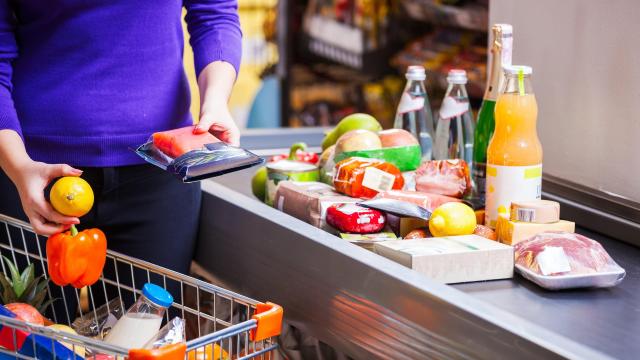Are you one of those elite grocery shoppers who calmly and methodically works your way through the aisles, cart tidy and organised, all produce in one section and boxes neatly stacked and standing upright? Or are you more of the hot mess variety, who flies through the store when you’ve got 20 minutes between baseball drop-off and daycare pickup, not so quietly muttering your list repeatedly so you don’t forget the damn bread (again) while chucking items in the cart wherever they’ll fit? Either way, you should probably organise your groceries at checkout.
Why can’t you just unload all the groceries willy-nilly on the conveyor belt? Well, you can. No harm will befall you if there’s no rhyme or reason to your groceries (except the silent judgment of your peers in line behind you). So why should you be bothered to organise when checking out?
Well, there are a few main reasons: First, to make the bagging process faster for either the cashier or yourself if a dedicated bagger isn’t available. Secondly, so refrigerated and frozen items won’t be bagged with items like cereal, perspiring as they thaw, warping and weakening the box. Third, keep the strong, chemical scent of cleaning products (and the risk of spills and contamination) away from your edible items. And lastly, to make the unpacking process simpler and faster when you arrive home.
How to organise groceries at checkout
There are a few (rather vehement) schools of thought on this. One says groceries should be grouped on the conveyor belt by how they are grouped in the store; dairy with dairy, produce with produce, meat with meat, etc. (An easier variation on this is to simply group all refrigerated and frozen items together while keeping all boxed, canned and other dry goods separate.) Another method is to place any heavy or box-shaped items on the belt first, so they can be placed in the bottoms of bags while saving lighter or fragile items like bread, eggs, and soft fruit for the end of the belt, to be placed on top.
Of course, you could go further. Certain gung-ho individuals group items by brand, (um, how many Hamburger Helpers are we buying?), keep pantry goods separate from toiletries, cold produce like lettuce separate from dry produce like bananas, and — get this — organise and bag by location in their kitchen. Others report conveying and bagging items “based on when they’ll be used: Things for dinner go in one bag, ingredients for lunchtime meal preps go in another, and so on, with the exception of raw meats and fragile items like eggs.”
If this were a competition, however, the winners would be those who utilise a two- or three-tiered system: First grouping by weight, then by refrigeration or purpose in their home (eating, cleaning, personal grooming), and lastly, by location in their kitchen or abode.
While this level of forethought and organisation is commendable, we’ll be over here, staying in our lane, separating items by temperature and calling it a day.

Leave a Reply
You must be logged in to post a comment.